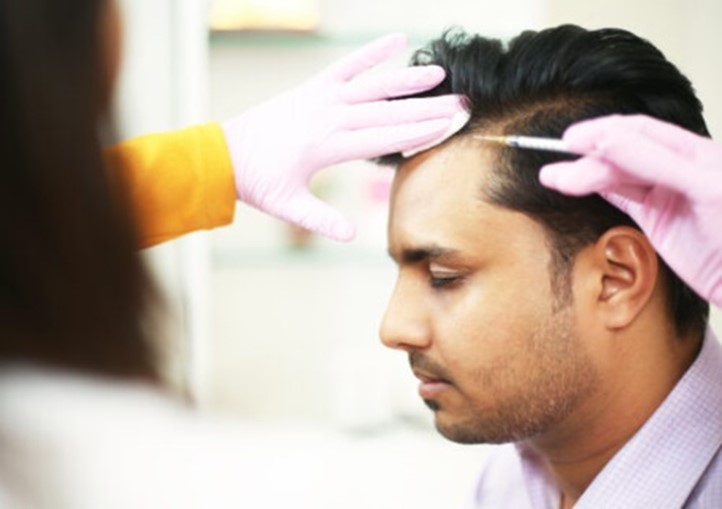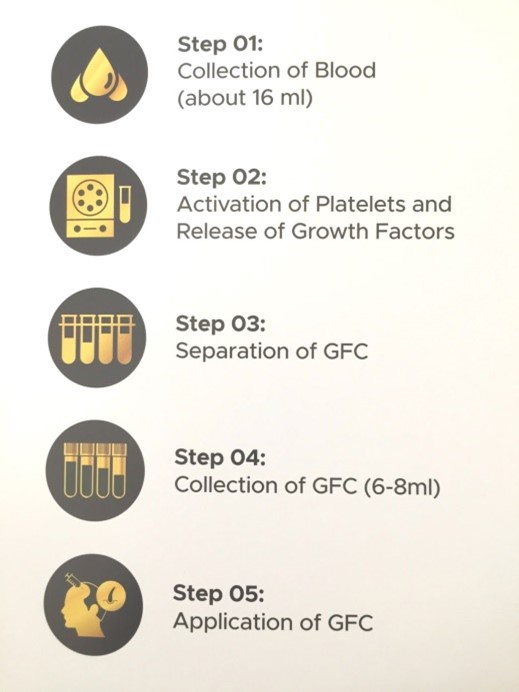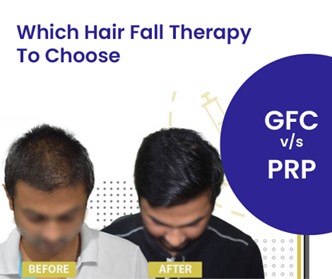Introduction
Hair loss is a common concern for both men and women, affecting millions of people worldwide. Whether due to genetic factors, hormonal imbalances, stress, or lifestyle choices, hair thinning and baldness can significantly impact one's self-esteem and confidence. While various treatments exist for hair restoration, Growth Factor Concentrate (GFC) therapy has emerged as a promising, non-surgical solution for regenerating hair naturally. GFC therapy leverages the body's own growth factors to stimulate hair follicles, enhance scalp health, and promote hair regrowth.
In this article, we will explore what GFC therapy is, how it works, the benefits it offers, the treatment process, comparisons with other hair restoration methods, and frequently asked questions. This comprehensive guide aims to shed light on the potential of GFC for hair regeneration and help individuals make informed decisions about this innovative treatment.
What is GFC Therapy for Hair Regeneration?
Growth Factor Concentrate (GFC) therapy is a cutting-edge treatment that uses the patient's own blood to harvest growth factors essential for hair follicle regeneration and stimulation. These growth factors, which are naturally present in the body, play key roles in cellular repair, growth, and regeneration. In the context of hair regeneration, GFC therapy involves isolating these growth factors from the blood and injecting them into areas of the scalp experiencing hair loss or thinning. This process helps reactivate dormant hair follicles, encouraging them to enter the anagen (growth) phase and produce new, healthy hair strands.
As a non-surgical, minimally invasive procedure, GFC therapy has gained popularity due to its natural approach to hair restoration and low risk of side effects. It is especially beneficial for individuals looking for alternatives to hair transplant surgery or traditional hair loss treatments that involve synthetic substances.

Understanding the Mechanism of GFC Therapy
The GFC therapy process involves a series of well-defined steps that maximize the efficacy of the treatment:
- Blood Collection:The procedure starts with drawing a small amount of the patient's blood, similar to a routine blood test. This blood serves as the source for extracting growth factors.
- Centrifugation and Growth Factor Isolation:The collected blood is then placed in a centrifuge, a device that spins it at high speeds to separate the plasma rich in growth factors from other components, such as red blood cells. This process isolates the concentrated growth factors required for hair regeneration.
- Preparation of Growth Factor Concentrate:The separated plasma is further processed to enhance the concentration of growth factors, such as platelet-derived growth factor (PDGF), transforming growth factor (TGF), vascular endothelial growth factor (VEGF), and others. These growth factors are crucial for cellular repair and regeneration.
- Injection into the Scalp: The prepared GFC is injected into specific areas of the scalp where hair thinning or baldness is noticeable. The growth factors work at the cellular level to stimulate hair follicles, encouraging them to produce thicker, stronger hair.
- Revitalization of Hair Follicles:Once introduced into the scalp, the growth factors activate the hair follicles, promote their transition into the active growth phase, and encourage the formation of new hair strands.
- Improved Blood Flow and Nutrient Delivery: GFC therapy also enhances blood circulation in the scalp, ensuring that hair follicles receive an adequate supply of nutrients and oxygen, which are essential for optimal hair growth.
- Collagen Production and Scalp Health:The growth factors present in GFC therapy stimulate collagen synthesis, which fortifies hair strands, strengthens the scalp's structure, and improves overall scalp health.
- Reduction of Inflammation:By reducing inflammation within the scalp, GFC creates a conducive environment for hair follicles to regenerate and thrive.
The Benefits of GFC Therapy for Hair Regeneration
Growth Factor Concentrate therapy offers a variety of benefits that make it an attractive option for individuals struggling with hair loss:
- Natural Treatment Approach:GFC therapy utilizes the patient's own blood-derived growth factors, which reduces the risk of allergic reactions and ensures compatibility with the body. It is a natural and biocompatible option compared to treatments involving synthetic chemicals.
- Non-Surgical Procedure:Unlike hair transplant surgery, GFC therapy does not require any surgical incisions, grafting, or stitching. It is a minimally invasive treatment with little to no downtime.
- Suitable for Different Types of Hair Loss:GFC therapy is effective for various forms of hair loss, including androgenetic alopecia (male or female pattern baldness), alopecia areata (patchy hair loss), and hair thinning due to stress or hormonal changes.
- Quick and Convenient Sessions: The procedure typically takes 30-60 minutes, depending on the treatment area. Patients can resume their normal activities shortly after the session.
- Long-Lasting Results with Maintenance:Results from GFC therapy can last for several months or even years with the appropriate maintenance sessions. Periodic follow-up treatments help sustain the effects and prolong hair growth.
- Improvement in Hair Quality and Thickness: Patients often notice not only an increase in hair density but also an improvement in hair texture, thickness, and strength.
- Minimal Side Effects: Since the treatment involves autologous growth factors (derived from the patient's blood), the risk of side effects is low. Common side effects may include mild redness, swelling, or bruising at the injection sites, which usually subside within a few days.
The Treatment Process: What to Expect
Individuals considering GFC therapy can expect the following steps during the treatment process:
- Consultation and Assessment:The first step involves a consultation with a dermatologist or hair restoration specialist to assess the patient's hair loss condition and determine if GFC therapy is suitable.
- Blood Draw and Preparation:During the procedure, a small amount of blood is drawn from the patient. The blood is then processed to isolate the growth factors through centrifugation.
- Injection of Growth Factors:The concentrated growth factors are injected into the scalp using fine needles. The injections are strategically placed in areas where hair thinning or baldness is most prominent.
- Post-Treatment Care: After the treatment, patients may be advised to avoid washing their hair for 24 hours and to stay away from direct sunlight or harsh hair products for a few days.
- Follow-Up Sessions:Multiple sessions may be recommended, usually spaced a few weeks apart, to achieve optimal results. Maintenance treatments may be performed every 6-12 months to maintain hair regeneration.

How Does GFC Compare to Other Hair Restoration Methods?
GFC vs. PRP (Platelet-Rich Plasma)
- Growth Factor Concentration:: GFC therapy uses a higher concentration of growth factors than traditional PRP, potentially offering superior results in fewer sessions. While PRP mainly relies on platelets, GFC involves the isolation of a broader range of growth factors.
- Procedure Frequency:GFC may require fewer treatments compared to PRP, which often involves monthly sessions to maintain hair growth.
GFC vs. Hair Transplants
- Non-Invasive Alternative:Unlike hair transplants that involve surgical grafting and recovery time, GFC therapy is non-surgical and involves minimal downtime.
- Scalp Health Benefits:In addition to promoting hair growth, GFC therapy improves overall scalp health by enhancing blood flow, stimulating collagen production, and reducing inflammation.

Scientific Support for GFC Therapy
Research supports the effectiveness of GFC therapy in hair regeneration:
- Androgenetic Alopecia Studies:Clinical studies have shown significant improvements in hair density and quality in individuals with androgenetic alopecia who underwent GFC therapy.
- Alopecia Areata Research:GFC therapy has been found to promote hair regrowth in individuals with alopecia areata, providing hope for those suffering from patchy hair loss.
These studies indicate that GFC therapy is a promising and scientifically-backed option for individuals looking to regenerate hair and improve scalp health.
Potential Side Effects and Precautions
Although GFC therapy is considered safe, some minor side effects may occur:
- Temporary Redness or Swelling:Mild swelling or redness at the injection sites is common and usually resolves within a few days.
- Bruising:Some patients may experience slight bruising, which typically fades within a week.
- Pre-Treatment Precautions:Patients should avoid blood-thinning medications, such as aspirin, for a few days before the procedure to reduce the risk of bruising.
Conclusion
Hair regeneration with Growth Factor Concentrate (GFC) therapy represents a significant advancement in the quest for effective hair restoration solutions. By utilizing the body’s own growth factors, GFC therapy stimulates hair follicles and promotes healthy hair growth in a natural, non-surgical manner. The treatment's minimally invasive approach, combined with its ability to improve scalp health and achieve noticeable results within months, makes it an attractive option for individuals experiencing various types of hair loss. Moreover, GFC stands out against traditional methods like hair transplants and PRP therapy, offering a higher concentration of growth factors with a lower risk of side effects.
As awareness and research surrounding GFC therapy continue to grow, more people are likely to explore this innovative treatment as a viable solution for their hair restoration needs. However, it is essential for individuals to consult with qualified professionals to assess their suitability for the procedure. Overall, GFC therapy not only addresses the physical aspects of hair loss but also helps individuals regain confidence and enhance their quality of life, marking a promising future for those affected by hair thinning and baldness.
GFC therapy involves using growth factors derived from the patient's own blood to stimulate hair follicles, encouraging hair regrowth and improving hair density.
GFC therapy involves a higher concentration of growth factors than PRP, potentially resulting in better outcomes with fewer sessions.
Typically, 3-5 sessions are recommended, spaced a few weeks apart. Maintenance sessions may be needed every 6-12 months.
Results are often noticeable within 3-6 months, with gradual improvements in hair density and quality.
Yes, GFC therapy can treat various forms of hair loss, including androgenetic alopecia, alopecia areata, and thinning due to stress or hormonal imbalances.
Yes, it can be combined with other hair restoration treatments, such as PRP or topical solutions, to enhance overall results.
Patients should avoid using hair styling products and blood-thinning medications for a few days before the treatment.
The downtime is minimal. Patients can resume their normal activities shortly after the treatment.
Since GFC uses autologous growth factors, long-term risks are minimal.
Before undergoing GFC treatment, it's essential to consult a specialist to discuss your hair loss concerns and medical history. Additionally, avoid taking blood-thinning medications, such as aspirin or ibuprofen, for a few days prior to the procedure to minimize the risk of bruising. Finally, make sure to follow any specific pre-treatment guidelines your practitioner may provide to ensure the best possible results.
